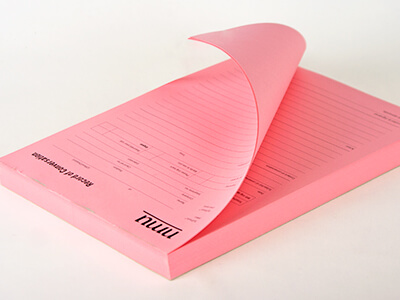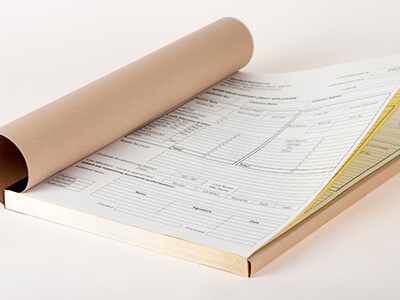NCR Forms


Contractor Permits for monitoring access
NCR Forms
Carbonless copy paper that gives instant duplicates.
No Carbon Required = NCR = National Cash Register, the corporation that pioneered this paper.
By encapsulating a sheet of paper with a layer of ink or a coating of reactive clay, information on that paper can be transferred onto a sheet beneath. When pressure is applied from writing or impact printing (by a dot matrix printer) then the ink capsules on the top sheet burst, react with the coating on the sheet below and transfer the mark permanently. Multiple coated sheets can yield multiple copies in one pass.
A set of two or more sheets is treated with an adhesive along one edge. These sets can be left glued together in a pad, separated out into loose sets or reinforced with covers and a tape spine to create a book.
JARGON BUSTER:
CB, CF, CFB A top copy has a Coated Back (CB) of ink that transfers to the clay Coated Front (CF) of the bottom sheet. Intermediate sheets are Coated Front and Back (CFB) with clay and ink respectively.
NCR paper weights For continuous stationery we usually print top sheets on paper weighing 60 grammes per square metre (gsm), bottom sheets on 57gsm and middle sheets on 53gsm. Thicker papers tend to hinder multiple (more than three) copies. 70gsm and 80gsm are common weights for two and three part sets, pads and books. Bottom sheets can go up to 160gsm.
Ask us for advice.
We don’t restrict you to standard size sheets and you can choose the combination and order of the coloured duplicates.
Need artwork for your forms? We can design your form from scratch to best suit your business, or recreate one from an existing printed sample.
NCR Loose Sets
Used for receipts, delivery notes, application forms and more.
Each multi-part set is glued along one edge to hold the parts together and each of these sets is separate – see pads and books for alternative bindings.
Both sides of the form can be printed on. The artwork can change for each part, showing different information or signifying ‘Customer’s Copy’, ‘Office Copy’ and so on.
TIPS:
Look good, save money. Print your top copy in full colour, but convert the lower copies to one colour which costs less to print.
Choose your colours. Standard NCR paper colours are white, green, pink, blue and yellow. If you have another colour in mind, we can use that to ‘wash’ the paper with a background tint instead.
NCR Pads
NCR sets collated into pads.
NCR sets are glued along one edge and fixed to a sturdy board back. Supplied with a writing shield to protect the sheets below the one in use. When used, all parts are detached from the pad. Consider a book for retaining the copies in one place.
NCR Books
Ideal for receipts, job sheets, enquiry forms and agreements.
Books are the most robust vehicle for your NCR forms. The sets will be stitched together and taped across the spine. Top copies will be perforated to allow their removal once completed, leaving the bottom copy fixed in the book. Books are backed with a sturdy board and finished with a wrap-around (or loose if you prefer) writing shield.
JARGON BUSTER:
Fast The copy, typically the bottom one, held in an NCR book while the duplicates are perforated for removal.
Tipped Glued eg; ‘tipped at head’ means the glue holding the sets together runs along the top edge of the document.
Stitched The printers’ term for stapled.
Wrap-around writing shield Pads and books should be finished with a cover that doubles as a protector when forms are being filled in. It is glued to the back board and folded around to cover the front. It can be printed or plain.
Finishing Options
Numbering.
Each form can be individually numbered in one or more positions – a feature particularly useful for invoices, delivery notes and the like.
A superior level of document verification and control can be achieved by printing a modulus number (or check digit).
Drilling.
We can hole punch NCR documents to suit your binding system.
Desensitising.
NCR papers are impregnated with a dye that transfers to its copy when pressure is applied. To prevent this happening to sensitive information, such as on financial or payroll forms, the area to be kept private is desensitised so the dye will not transfer. As an alternative measure, we can print a cross hatching which will render the private area illegible.
Printed Covers.
Don’t settle for plain – promote your brand or display instructions by printing on your covers or writing shields.
Get in Touch
Please contact us to chat about your project
or to discuss how to make your print work effectively for you.
Call us on 0121 359 7931 or 0121 753 7930



